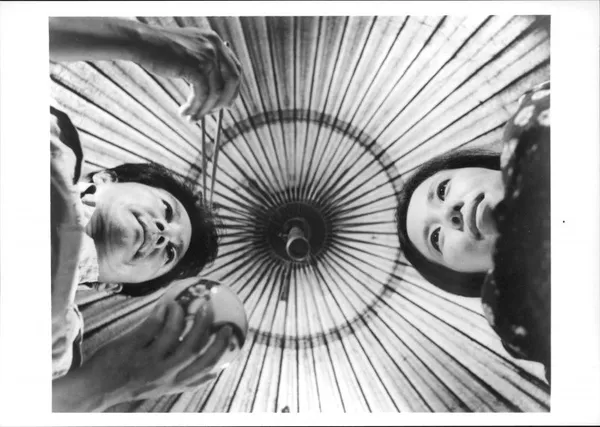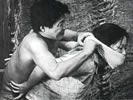Eye For Film >> Movies >> Woman Of The Dunes (1964) Film Review

Hiroshi Teshigara's film opens with the image of a strange crystal shape whose uneven enormity fills the entire screen, challenging viewers to identify what it is. The next, equally baffling shot, taken from further back, is of a pyramid-like pile of these alien rocks, still difficult to recognise in all their misshapenness. Finally, the camera pulls out to a distance, revealing that the boulders are in fact countless tiny grains of sand forming a desert dune.
It is a beautiful, mysterious sequence that foreshadows the two elements that will come to dominate the film: the microscopic scrutiny to which an apparently simple scenario and blank characters will be subjected, exposing all manner of hidden complexities and the inescapable ubiquity of sand, covering the sets, caking bared flesh, and filling the soundtrack with its constant presence.

On a field trip to a remote desert coastal region, a schoolteacher and amateur entomologist (Eiji Okada) falls asleep in the stark sunlight, and wakes to find that he has missed the last bus back to Tokyo. Local villagers suggest he lodge overnight with a young widow (Kyoko Kishida) who lives nearby, and lower him by a rope ladder into the large sandpit where her shack is located.
The following morning, he finds that he has been tricked: the ladder is gone, there is no way up the crumbling walls all around him, and if he does not help every night in shoveling away the sand that endlessly pours into the pit, the house, and possibly the entire village, will be buried. In time a bond develops between the lonely woman and her reluctant 'guest', a fragile accommodation is reached, and even the entomologist's determination to escape is gradually eroded as he finds for himself a new and unexpected sense of purpose in his harsh surroundings.
So disarmingly simple is the premise of Woman Of The Dunes, so sparse are its landscapes, and so economic its characterisation, that the film's desert becomes a mythic space onto which all manner of allegorical interpretations can be projected.
Does the entomologist embody post-war Japan, trying to claw its way out of a dead-end past to a more rationalised future? Is he a 20th century Everyman, alienated, rootless, restless, emasculated and incapable of love? Or is he a Sisyphus figure, doomed forever to a hell of futilely repetitive labour? Or perhaps a Kafkaesque anti-hero, pinned down like one of the bugs that he collects yet longing to take wing and rise above his mundane existence? Is his relationship with the widow outlandish from start to finish, or is it really just like any marriage of convenience, complete with opportunistic sex and the sort of guarded affection that comes only from habit? Is the entomologist ultimately a deluded prisoner, or has he achieved true freedom in the most unlikely of circumstances? And might not the film's decidedly surreal events all just be dreamt up by the entomologist as he dozes under the sun and tries to imagine escaping a troubled marriage and an over-regimented life in the city?
In the end such questions remain mere riddles in the sand, but there can be no doubt that Woman Of The Dunes, the second (after 1961's Pitfall) of Teshigahara's collaborations with the avant-garde novelist Kobo Abe and the experimental composer Toru Takemitsu, is a richly evocative masterpiece of domestic claustrophobia, erotic tension and existential crisis.
Cinematographer Hiroshi Segawa's use of feverish camera angles and unusual close-ups ensures that the cabin setting, though confined, is always a place of nervous thrills, while Takemitsu's discordant soundtrack combines shrill string glissandi with pounding tribal drums, insect scuttles and howling wind, leaving viewers no chance to relax or drift. Okada and Kishida give performances of intense (but incompatible) longing, and do not shy from their characters' less agreeable sides. Best of all, though, is the sand itself, rippling, spilling and entrapping in a compelling vision of nature at its most oppressive and unrelenting.
Like Kaneto Shindo's Onibaba (which was released in the same year), Woman Of The Dunes is a raw portrait of existence in extremis. As beguiling, enigmatic and timeless as the shifting sands, Teshigahara's finest film pulls the viewer in and refuses to let go.
Reviewed on: 03 Oct 2006

















